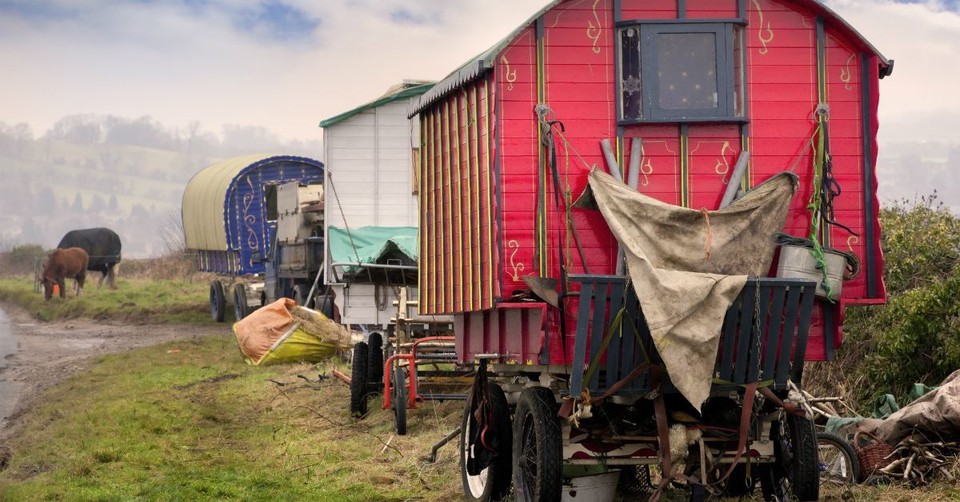Who Are the Gypsies and What Do They Believe?

“A gypsy must’ve come in the night and stolen our best hen.” I was in rural Spain in 2002 when I overheard an elderly couple discussing a broken latch on their chicken coop door and a missing hen.
A week later, my family and I attended a crowded festival in a medieval Spanish town and were warned by locals to “watch out for the gypsies,” described as “thieves,” “beggars,” and “swindlers who rig the festival games.”
After my vacation, I returned to work and mentioned this all to a co-worker. Furrowing his brows, he insisted that I must’ve misunderstood what the locals had said because “gypsies aren’t real.”
Who are the Gypsies and what do they believe?
The term "gypsies" refers to an ethnic group of people called the Roma or the Romani (also spelled Romany). The Roma are not to be confused with Romanians or with the Romans, both of which are distinct ethnic groups from the Roma.
The Romanies follow several different faiths, adopting the predominant religion of their particular country of residence. Some Romani follow a Christian denomination while others are Muslim.
Genetic research has shown that the Roma descend from a single group of people who left northwestern India 1,500 years ago. In the centuries that followed, Romanies spread throughout Europe and, by the 19th century, had migrated to the Americas.
Today, the Romani are a diverse people living in every inhabited continent in the world. The language of the Romani is also called Romani. Romani includes various distinct dialects, all of which derive from Sanskrit and are closely related to India’s Hindi language.
What is the origin of the word “gypsy?”
The word “gypsy” originated in the 16th century and meant Egyptian, since Romanies were initially believed to be from Egypt. The word “gypsy” is often considered derogatory due to its usage to connote illegal behavior and a wandering lifestyle, instead of as an identifier for a particular race of people.
The word “gyp,” which means to swindle, is also offensive to Romanies because the word likely derives from the word “gypsy” and stereotypes all those thought to be “gypsies” as swindlers.
What was life like for the first European Romanies?
Historians believe that the original Romani population who migrated to Europe were distrusted by the Europeans as a displaced people with a strange, nomadic lifestyle.
The Romani people (gypsies) have been discriminated against in Europe for centuries.
Europeans have long portrayed the Roma/Gypsies as cunning outsiders who steal from local residents before moving on to the next town.
Because of this distrust, European nations over the centuries have enslaved, expelled, imprisoned, and executed Romani people. Other European nations used their legal system to oppress the Roma, passing laws prohibiting Romanies from buying land or securing stable professions.
Some believe that these legal restrictions placed on the Roma necessitated the continuation of their itinerant lifestyle, forcing Romanies to live on the perimeters of settled society for centuries. These nomadic Roma (gypsies) traveled in horse-drawn, brightly-colored wagons and sought jobs conducive to a transient lifestyle. Such jobs included working as livestock traders, animal trainers and exhibitors, entertainers, fortune tellers, and metalsmiths.
The Roma’s (gypsies) traveling culture has historically hindered education.
Based on discrimination against the Roma coupled with their migratory culture, school attendance and literacy rates among Romanies have traditionally been low. In fact, most of what we know about the Romani culture has been passed down through oral histories because the Romani language remains largely unwritten.
Traditional Romani and Gypsy culture upholds family, customs, and self-governance.
As a displaced people targeted by popular society, Romani culture focuses heavily on family, customs, and self-governance. In Romani communities that remain itinerant, the groups travel in bands made up of ten to several hundred extended families traveling together in caravans. Each band elects a male leader to govern the group, and a female leader to ensure the welfare of the band’s women and children.
Romanies/gypsies are also expected to support the larger Romani community by attending events within the community such as weddings, christenings, and funerals. Not attending these events could be viewed as disrespectful and may eventually lead to isolation from the broader Romani community.
Many Roma also follow traditional Romani customs. For example, once a Romani/gypsy girl reaches puberty, she’s expected to wear long skirts and dresses. Further, some Romani groups still follow the practice of arranged marriages, teen marriage, and "bride prices" paid by the groom’s family to the bride’s family.
The Roma also have their own internal system of self-governance to address accusations of misconduct. In particular, community leaders and courts of elders are responsible for adjudicating conflicts and administering punishments within their particular Romani group. Punishment can include a loss of reputation and, in extreme cases, expulsion from the Romani community.
What is life like for the modern Romani people?
Europe has the largest Romani/Gypsy population, home to an estimated 10 to 12 million Roma, most of whom live in Central and Eastern Europe. Some European Romanies remain nomadic, living in camps or caravans and moving from town to town in cars and RVs.
Today’s Roma (Gypsies) in Europe
However, many of today’s Roma lead settled lives. Despite settling down, the Roma remain one of Europe’s most disadvantaged ethnic groups, with 80% of Romanies living below the poverty line as of 2016. Moreover, government policies in certain European nations have sought to prevent Romani integration by hindering the Roma’s access to housing, education, and employment.
In recent years, there have been alarming reports of anti-Roma discrimination in Europe, including the systematic demolishing of Roma camps and deportation of thousands of Roma at a time in France, and the horrific forced sterilization of Romani women in countries such as the Czech Republic and Slovakia.
In addition, in March of 2019, Amnesty International filed a complaint before the European Committee of Social Rights against the Italian government, alleging international violations against Romanies in Italy, including “widespread forced evictions…use of segregated camps featuring substandard housing and lack of equal access to social housing.”
The plight of the Romanies is also a major concern of the children’s rights organization UNICEF, which is currently working to increase literacy among Romani children in Europe through home-visitation programs that connect new parents with child education and social services.
Today’s Roma (Gypsies) in America
There are an estimated 1 million Roma living in the United States, arriving here from different countries and speaking different languages. The U.S. has played a role in discrimination against Romanies in the past, as some states have on their books repealed laws that limited where Romanies could rent property, where they could entertain, and what goods they could sell.
However, precise statistics about American Romanies are limited due to:
- The lack of studies assessing the socio-economic realities of American Romani
- The absence of Romani information on census returns
- The trend of some American Romanies to hide their Romani heritage as a holdover mentality rooted in the discrimination their forefathers endured in Europe
- The lack of awareness among some Americans that the Romani arean actual ethnic group, not “a Halloween costume” or” fictional characters with “wagons and horses and tambourines”
In an effort to remedy the lack of statistics on American Romanies, Harvard University has recently launched a study to assess the structural, social, and economic status of American Romani communities.
What can Christians learn from the Romani/Gypsy lifestyle?
Any Christian partial to the classical music of Tchaikovsky, Schubert, Haydn, or Brahms, or any Christian awed by the beauty and rhythm of flamenco can thank the Romani, whose acclaimed musical heritage heavily influenced these musical styles.
Further, although Christians will find some Romani traditions offensive—such as arranged marriages and bride prices—there are other Romani traditions worthy of emulation. Among these traditions are the Roma’s inclusion of extended family members, respect for the elderly, and sense of solidarity.
It’s important to note that many of the nations criticized for discriminating against the Romani are largely Christian nations, i.e. Italy, France, and Slovakia. Recently, as an important gesture to help heal the wounds and undo the division caused by Christian oppression of Romanies, Pope Francis met with a Romani community, asked for forgiveness, and apologized that Christians have historically regarded Romanies “with the look of Cain rather than Abel.”
How should Christians respond to the Romani people?
Christians should respond to the Romani community in the same way that they would respond to any other child of God—by doing unto others as you’d have done unto you (Luke 6:31), and by remembering that whatever you do for the least of your brothers and sisters, you do for the Lord (Matthew 25:40).
On a final note, we should never doubt the ability of people to embrace acceptance. Less than 20 years after my trip to Spain and my first exposure to the negative stereotypes about Romanies, Spain is now regarded as a country that is successfully implementing programs to help empower and integrate its Romani population.

Photo Credit: ©GettyImages/AndyRoland.jpg
Originally published August 30, 2019.







